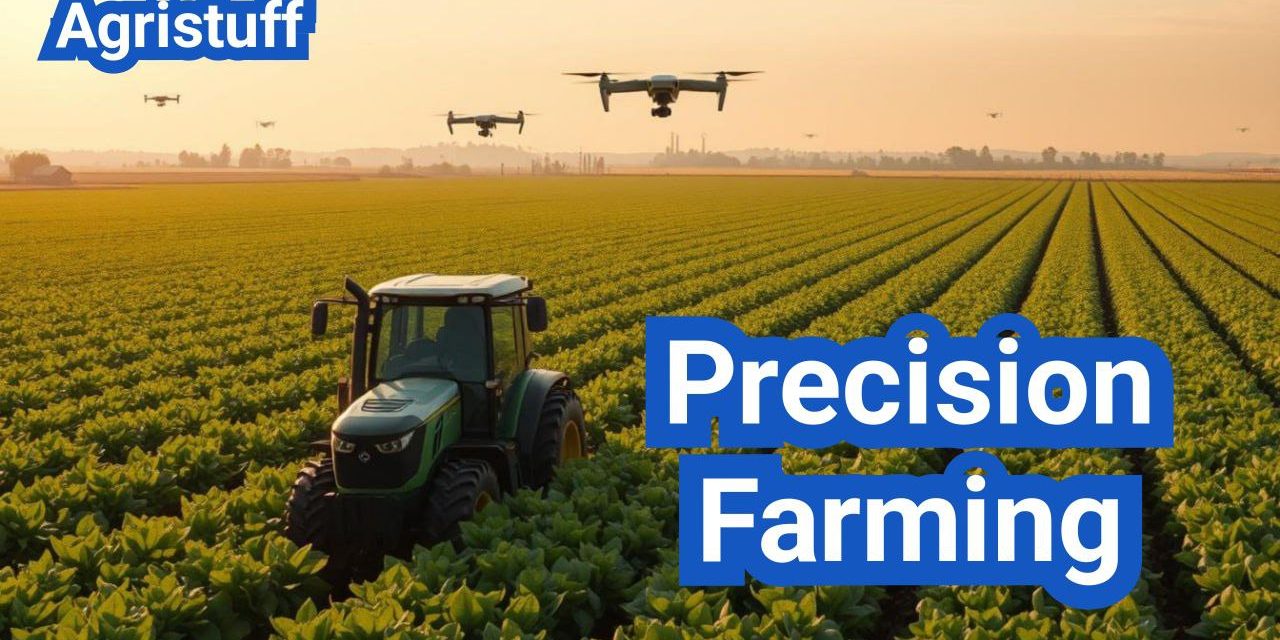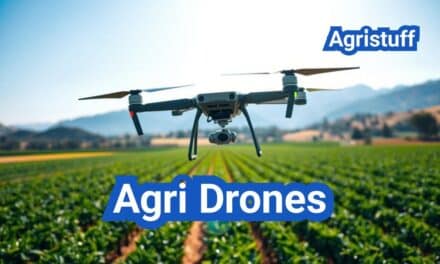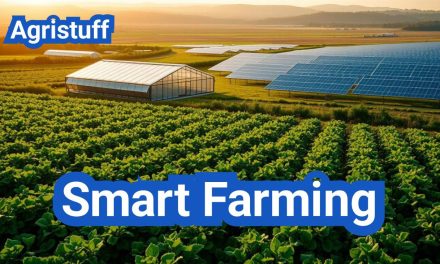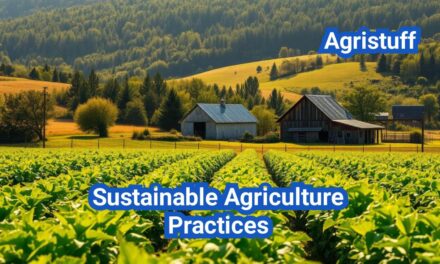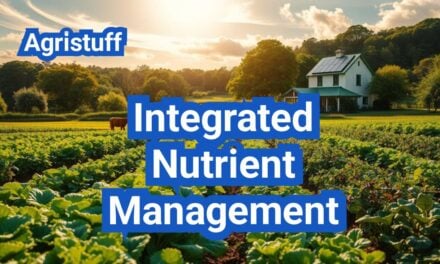The agricultural industry is undergoing a significant transformation with the advent of precision agriculture. By leveraging advanced technologies, farmers can now optimize crop yields, reduce waste, and promote sustainable practices.
Precision farming technology has already shown promising results, with studies indicating a 4% increase in production, 7% reduction in fertilizer use, and 9% decrease in herbicide applications. Companies like John Deere are at the forefront of this revolution, offering ag GPS systems and other innovative solutions.
The integration of smart farming techniques and digital agriculture is redefining the future of farming. As the global population continues to grow, the importance of precision farming will only continue to increase.
Key Takeaways
- Precision agriculture is transforming the farming industry.
- Advanced technologies optimize crop yields and reduce waste.
- Precision farming promotes sustainable agricultural practices.
- Companies like John Deere are leading the precision farming revolution.
- Smart farming and digital agriculture are key to the future of farming.
What Is Precision Farming?
Precision agriculture is an innovative farming management concept that leverages modern technology to observe, measure, and respond to the changing conditions and states of crops by using real-time data.
Definition and Core Concepts
Precision farming involves the use of advanced technology, including GPS, drones, and sensors, to optimize crop yields and reduce waste. The core concept revolves around making farming more precise and efficient by using data-driven insights.
The key elements include data collection, analysis, and precision application of inputs like water, fertilizers, and pesticides.
| Core Concept | Description |
|---|---|
| Data Collection | Gathering information on soil, weather, and crop conditions |
| Analysis | Interpreting data to identify trends and patterns |
| Precision Application | Applying inputs precisely where and when needed |
How Precision Farming Differs from Traditional Agriculture
Precision farming differs significantly from traditional agriculture in its approach to crop management. Unlike traditional farming, which often relies on uniform application of resources across the entire farm, precision farming tailors the application of inputs to the specific needs of different areas within the farm.
This targeted approach not only improves efficiency but also reduces environmental impact by minimizing waste and conserving resources.
The Evolution of Precision Farming Technology

As we explore the evolution of precision farming, it becomes clear that technological advancements have played a crucial role in shaping modern agriculture. The transformation from traditional farming methods to precision agriculture has been significant, driven by the need for increased efficiency and productivity.
Historical Development
The history of precision farming is rooted in the early 20th century, but it’s the recent technological leaps that have truly transformed the industry. The introduction of GPS technology in the 1990s marked a significant turning point, enabling farmers to navigate and map their fields with unprecedented accuracy.
The development of precision agriculture has been a gradual process, with various technologies being adopted over the years. From the early use of satellite imaging to the current deployment of drones and IoT devices, each innovation has built upon the last, creating a complex and integrated farming system.
Key Milestones in Precision Agriculture
Several key milestones have defined the evolution of precision farming. The introduction of Variable Rate Technology (VRT) allowed farmers to apply inputs such as fertilizers and pesticides at varying rates across a field, optimizing crop yields and reducing waste.
| Year | Milestone | Impact |
|---|---|---|
| 1990s | Introduction of GPS technology | Enabled accurate field navigation and mapping |
| 2000s | Adoption of VRT | Optimized input application, reducing waste and improving yields |
| 2010s | Deployment of drones and IoT devices | Enhanced crop monitoring and data collection capabilities |
These advancements have collectively contributed to the sophisticated precision farming technologies available today, revolutionizing the way farmers work and improving the sustainability of agricultural practices.
Why Precision Farming Matters in Modern Agriculture
With the world’s population projected to reach 9 billion by 2050, precision farming is becoming increasingly important. As the global population continues to grow, the demand for food production is rising, putting pressure on agricultural systems to produce more with limited resources.
Addressing Global Food Security Challenges
Precision agriculture is crucial in optimizing soil use and preserving its quality for future generations. By leveraging advanced technologies such as GPS, drones, and sensor systems, farmers can monitor and manage their crops more effectively, reducing waste and improving yields. This ensures a stable and sustainable food supply, which is crucial in addressing the global hunger challenge.
| Precision Farming Technique | Benefit | Impact on Food Security |
|---|---|---|
| Precision Irrigation | Water Conservation | Increased crop yields |
| Crop Monitoring | Early Detection of Issues | Reduced crop loss |
| Soil Sensing | Optimized Fertilizer Application | Improved soil health |
Environmental Impact Considerations
The environmental benefits of precision farming are significant. By using precision agriculture techniques, farmers can reduce their environmental footprint by minimizing the use of water, fertilizers, and pesticides. This not only helps to protect biodiversity but also contributes to a more sustainable food system.
Key environmental benefits include: reduced chemical runoff, conservation of water resources, and protection of soil health. By adopting precision farming practices, farmers can play a critical role in mitigating the environmental impact of agriculture.
Core Technologies Powering Precision Farming

At the heart of precision farming are innovative technologies that are reshaping the future of agriculture. These technologies enable farmers to make data-driven decisions, optimize resources, and improve crop yields.
Smart Farming and Digital Agriculture
Smart farming integrates advanced technologies like IoT, AI, and big data to enhance farming practices. Digital agriculture involves the use of digital tools to analyze and manage farm data, leading to more efficient farming operations.
- Real-time monitoring of crop health
- Predictive analytics for yield optimization
- Automated irrigation and fertilization systems
IoT Applications in Agriculture
The Internet of Things (IoT) plays a crucial role in precision farming by connecting devices and sensors to collect and share data. This enables farmers to monitor and manage their farms more effectively.
- Soil moisture sensors for optimized irrigation
- Weather stations for accurate forecasting
- Drones equipped with cameras for crop monitoring
Integrated Technology Systems
Integrated technology systems combine various precision farming technologies to create a cohesive and efficient farming operation. These systems enable seamless data exchange and analysis, leading to better decision-making.
Key benefits include improved crop yields, reduced waste, and enhanced resource allocation. By leveraging these technologies, farmers can achieve greater sustainability and profitability.
GPS Systems in Precision Agriculture
The use of GPS in agriculture has opened up new avenues for precision farming, allowing for more accurate and efficient farming practices. GPS technology is indispensable in precision agriculture, from guiding tractors to exact locations in the field to monitoring crop health and soil conditions.
How GPS Systems Transform Farming Operations
GPS systems have revolutionized farming operations by enabling farmers to navigate their fields with precision, reducing overlap, and improving crop yields. With GPS guidance, farmers can optimize planting, spraying, and harvesting, leading to more efficient use of resources.
Key benefits of GPS in farming operations include:
- Improved accuracy in planting and harvesting
- Reduced fuel consumption and costs
- Enhanced crop yields through optimized farming practices
Types of Agriculture GPS Systems
There are various types of GPS systems used in agriculture, including:
- Standalone GPS receivers
- GPS-enabled guidance systems
- RTK (Real-Time Kinematic) GPS systems for high-precision applications
Each type of GPS system offers different levels of precision and functionality, catering to the diverse needs of farmers.
Implementation Strategies for GPS Farming
To effectively implement GPS farming, farmers should consider the following strategies:
- Assess their farm’s specific needs and terrain
- Choose the appropriate GPS technology based on their needs
- Integrate GPS data with other precision agriculture tools
By adopting these strategies, farmers can maximize the benefits of GPS technology and improve their overall farming operations.
“The precision agriculture market is expected to grow significantly, driven by the adoption of GPS technology and other precision farming practices.” – As noted by industry experts, the future of farming lies in embracing technology to enhance efficiency and productivity.
Drone Technology in Precision Farming

The advent of drone technology has revolutionized the agricultural sector, offering unprecedented precision in farming practices. Drones equipped with various sensors and cameras enable farmers to gather detailed data on crop health, soil moisture, and other critical factors.
Types and Capabilities
Precision agriculture drones come in various types, each with unique capabilities. Multispectral, thermal, and hyperspectral imaging are some of the advanced technologies used in these drones. They allow for detailed soil analysis, crop monitoring, and detection of issues such as pest infestations or nutrient deficiencies.
According to a report, “Drones can capture high-resolution images that help farmers identify problems early, reducing the need for excessive pesticide use and improving crop yields.”
“The use of drones in agriculture is not just about saving time; it’s about making farming more sustainable.”
Drone Applications in Crop Monitoring
Drones are extensively used in crop monitoring due to their ability to provide real-time data. They can be equipped with sensors to monitor crop health, detect weeds, and assess soil conditions. This information enables farmers to make informed decisions, optimizing their farming practices.
The applications of drones in crop monitoring include:
- Crop health assessment
- Soil moisture monitoring
- Pest and disease detection
Integrating Drone Data with Farm Management Systems
One of the key benefits of using drones in precision farming is the ability to integrate the collected data with farm management systems (FMS). This integration allows for seamless analysis and implementation of the data, leading to more efficient farming practices.
By combining drone data with FMS, farmers can optimize irrigation schedules, fertilizer application, and pest control measures, ultimately enhancing crop yields and reducing environmental impact.
Agricultural Sensors and Data Collection

Agricultural sensors play a pivotal role in precision farming by providing real-time insights into field conditions. These sensors enable farmers to make data-driven decisions, optimizing crop yields and reducing waste.
Types of Sensors Used in Precision Farming
Precision farming employs a variety of sensors, including soil moisture sensors, temperature sensors, and optical sensors. These sensors monitor different aspects of the crop and soil environment.
Soil Moisture Sensors: Measure the water content in the soil, helping farmers optimize irrigation.
Temperature Sensors: Monitor soil and air temperature, crucial for crop health and growth.
| Sensor Type | Function | Benefits |
|---|---|---|
| Soil Moisture Sensors | Measure soil water content | Optimize irrigation, reduce water waste |
| Temperature Sensors | Monitor soil and air temperature | Enhance crop health, predict frost events |
| Optical Sensors | Assess crop health and growth | Detect issues early, improve yields |
Soil and Crop Monitoring Sensors
Soil and crop monitoring sensors are crucial for understanding the condition of the soil and the health of the crops. These sensors can detect nutrient deficiencies, moisture levels, and signs of stress or disease.
Crop Monitoring: Sensors like NDVI (Normalized Difference Vegetation Index) sensors assess crop health and vigor, allowing for targeted interventions.
Weather Stations and Environmental Monitoring
Weather stations on farms provide critical environmental data, including temperature, humidity, wind speed, and rainfall. This information helps farmers make informed decisions about planting, irrigating, and harvesting.
Environmental Monitoring: Includes tracking parameters like soil pH, salinity, and nutrient levels, ensuring optimal growing conditions.
Variable Rate Technology: Optimizing Input Application
Variable rate technology (VRT) is revolutionizing the way farmers apply inputs such as seeds, fertilizers, and pesticides. By enabling the precise application of these inputs based on site-specific data, VRT helps in optimizing crop yields and reducing waste.
Principles of Variable Rate Application
The core principle of VRT lies in its ability to adjust the rate of input application according to the variability within a field. This is achieved through the use of advanced technologies like GPS, GIS, and sensors that collect data on soil conditions, crop health, and other factors. By analyzing this data, farmers can create detailed maps that guide the application of inputs at the right rate and place.
Equipment and Implementation
Implementing VRT requires specialized equipment such as variable rate controllers, GPS systems, and compatible application machinery. The process begins with data collection, followed by the creation of application maps. These maps are then used to guide the variable rate equipment, ensuring that inputs are applied precisely where needed.
The equipment used for VRT includes:
- Variable rate seeders
- Fertilizer applicators
- Pesticide sprayers
Measuring ROI from Variable Rate Technology
To measure the return on investment (ROI) from VRT, farmers need to track changes in input costs, crop yields, and overall profitability. By comparing data before and after the implementation of VRT, farmers can assess its impact on their operations.
| Metric | Pre-VRT | Post-VRT |
|---|---|---|
| Seed Cost | $100/acre | $80/acre |
| Fertilizer Cost | $150/acre | $120/acre |
| Crop Yield | 200 bushels/acre | 220 bushels/acre |
By analyzing such data, farmers can determine the effectiveness of VRT in their operations and make informed decisions about its continued use.
Data Management in Precision Farming

Data management plays a pivotal role in precision farming, enabling farmers to make informed decisions. The ability to collect, process, and analyze vast amounts of data is crucial for optimizing farming operations.
Collecting and Processing Agricultural Data
The first step in effective data management is the collection of agricultural data. This involves gathering information from various sources such as sensors, drones, and GPS systems. The data is then processed to remove any inconsistencies and formatted for analysis.
Farm Management Information Systems
Farm Management Information Systems (FMIS) are software applications that help farmers manage their operations by analyzing the collected data. FMIS can provide insights into crop health, soil conditions, and weather patterns, enabling farmers to optimize their practices.
Data Privacy and Ownership Considerations
As precision farming relies heavily on data, there are growing concerns about data privacy and ownership. Farmers need to be aware of who owns the data collected on their farms and how it is being used. Ensuring data privacy and security is essential for maintaining trust in precision farming technologies.
By implementing robust data management practices, farmers can unlock the full potential of precision farming, leading to improved crop yields and reduced operational costs.
Implementing Precision Farming: A Step-by-Step Guide

Implementing precision farming requires a strategic approach, starting with a thorough assessment of the farm’s requirements. This guide will walk you through the essential steps to successfully integrate precision agriculture into your farming practices.
Step 1: Assessing Your Farm’s Needs
The first step in implementing precision farming is to assess your farm’s specific needs. This involves evaluating your soil types, crop yields, and existing farming practices to identify areas where precision agriculture can make a significant impact. Key considerations include:
- Soil condition and variability
- Crop health and yield monitoring
- Irrigation system efficiency
- Existing equipment compatibility
Step 2: Selecting Appropriate Technologies
Once you have assessed your farm’s needs, the next step is to select the appropriate precision farming technologies. This could include GPS systems, drones, agricultural sensors, or variable rate technology. When choosing technologies, consider factors such as:
- Compatibility with existing equipment
- Scalability and flexibility
- Data integration and analysis capabilities
- Cost-benefit analysis
Step 3: Training and Integration Strategies
Effective implementation of precision farming technologies requires comprehensive training for farm staff. Develop a training program that covers the operation, maintenance, and data interpretation for the chosen technologies. Additionally, consider integration strategies to ensure seamless incorporation into your existing farming practices.
Step 4: Monitoring and Evaluation Processes
The final step is to establish ongoing monitoring and evaluation processes to assess the effectiveness of your precision farming implementation. This involves regularly reviewing data collected from precision agriculture technologies, analyzing the results, and making adjustments as needed to optimize your farming operations.
By following these steps, farmers can successfully implement precision farming practices, leading to improved efficiency, productivity, and sustainability.
Economic Benefits of Precision Farming

Precision agriculture is revolutionizing farming by providing numerous economic benefits. By leveraging advanced technologies, farmers can optimize their operations, reduce costs, and improve yields.
Cost Reduction Opportunities
One of the significant economic benefits of precision farming is the reduction in costs. By using precision agriculture techniques, farmers can minimize the use of inputs such as seeds, fertilizers, and fuel. For instance, precision farming enables farmers to apply fertilizers and pesticides only where needed, reducing waste and environmental impact. According to a study, farmers using precision agriculture techniques can save up to 10% on input costs.
Cost savings can also be achieved through more efficient irrigation management. Precision farming allows farmers to monitor soil moisture levels and adjust irrigation accordingly, reducing water waste and lowering energy costs associated with pumping water.
Yield Improvement and Revenue Enhancement
In addition to cost reduction, precision farming also offers opportunities for yield improvement and revenue enhancement. By using data analytics and precision agriculture techniques, farmers can identify areas of their fields that require more attention, allowing them to take targeted action to improve crop health and yields.
As John Deere notes, “Precision agriculture helps farmers to maximize their yields while minimizing their inputs.” By improving yields and reducing costs, farmers can increase their revenue and improve their bottom line. Furthermore, precision farming enables farmers to produce high-quality crops, which can command a premium price in the market.
“The use of precision agriculture has allowed us to reduce our input costs and improve our yields, resulting in significant economic benefits.” –
Farmers Using Precision Agriculture
Precision Farming and Sustainable Agriculture

Precision farming plays a vital role in advancing sustainable agriculture by leveraging cutting-edge technology. This approach not only enhances farming efficiency but also contributes to a more environmentally friendly agricultural practice.
Reducing Chemical Inputs and Runoff
One of the significant benefits of precision farming is its ability to reduce chemical inputs and runoff. By using precision application techniques, farmers can minimize the use of fertilizers and pesticides, thereby decreasing the amount of chemicals that enter waterways. This not only protects aquatic ecosystems but also reduces the environmental impact of farming.
Conservation of Water and Soil Resources
Precision farming also aids in the conservation of water and soil resources. Techniques such as precision irrigation and soil moisture monitoring enable farmers to optimize water usage, reducing waste and preserving this vital resource. Additionally, precision farming helps in maintaining soil health by minimizing erosion and promoting sustainable soil management practices.
Long-term Environmental Benefits
The long-term environmental benefits of precision farming are substantial. By adopting sustainable practices, farmers can contribute to a healthier ecosystem, improve biodiversity, and mitigate the effects of climate change. The use of precision farming technologies ensures that agricultural practices are not only productive but also environmentally sustainable.
The integration of precision farming with sustainable agriculture practices is a step towards a more environmentally conscious and productive farming industry. As technology continues to evolve, the potential for precision farming to contribute to sustainable agriculture will only grow.
Case Studies: Precision Farming in Action

Case studies on precision farming reveal its potential in revolutionizing traditional farming practices. By leveraging advanced technologies, farmers can significantly improve crop yields, reduce waste, and promote sustainable agriculture.
Real-world Farm Implementation Examples
Several farms have successfully implemented precision farming techniques, achieving remarkable results. For instance, a farm in Iowa used GPS-guided tractors and drones to monitor and manage their cornfields, resulting in a 15% increase in yield.
The use of precision farming has also been beneficial for farms with varied topography. A vineyard in California employed soil sensors and variable rate irrigation to optimize water usage, leading to a 20% reduction in water consumption.
| Farm | Technology Used | Outcome |
|---|---|---|
| Iowa Corn Farm | GPS-guided tractors, drones | 15% increase in yield |
| California Vineyard | Soil sensors, variable rate irrigation | 20% reduction in water consumption |
Precision Farming in Simulation Games (FS22)
Precision farming is not only being adopted in real-world agriculture but is also being represented in simulation games like Farming Simulator 22 (FS22). Players can experience the benefits of precision farming firsthand, using virtual GPS systems, drones, and other technologies to manage their virtual farms.
The inclusion of precision farming techniques in FS22 adds a layer of realism and complexity to the game, allowing players to understand the potential benefits and challenges of implementing these technologies in real life.
Challenges and Limitations in Precision Farming Adoption
The adoption of precision farming is hindered by several challenges that farmers and agricultural businesses must navigate.
Technical Barriers
One of the primary challenges is the technical complexity of precision farming systems. Integration of various technologies, such as GPS, drones, and sensors, requires significant technical expertise. Moreover, issues with data compatibility and interoperability can hinder the seamless operation of these systems.
Economic Constraints
Economic constraints are another significant barrier to the adoption of precision farming. The initial investment in precision farming technologies can be substantial, making it difficult for small-scale farmers to adopt these practices. A comparison of the costs associated with traditional farming methods versus precision farming is illustrated in the table below.
| Cost Component | Traditional Farming | Precision Farming |
|---|---|---|
| Equipment Costs | $100,000 | $150,000 |
| Technology and Software | $0 | $20,000 |
| Training and Support | $5,000 | $10,000 |
Knowledge and Training Gaps
Finally, there are significant knowledge and training gaps that must be addressed. Farmers need training to effectively use precision farming technologies and to interpret the data generated by these systems. Investing in education and training programs is crucial for overcoming these challenges and ensuring the successful adoption of precision farming practices.
Future Trends in Precision Farming Technology
As we look ahead, it’s clear that precision farming technology will continue to evolve, incorporating cutting-edge solutions like AI and robotics. The future of agriculture is being shaped by these advancements, promising to make farming more efficient, productive, and sustainable.
Artificial Intelligence and Machine Learning
Artificial Intelligence (AI) and Machine Learning (ML) are set to play a pivotal role in the future of precision farming. These technologies enable farmers to make data-driven decisions, predict crop yields, and detect issues before they become major problems. AI-powered systems can analyze vast amounts of data from various sources, including drones, sensors, and satellite imagery, to provide insights that were previously unimaginable.
For instance, AI can help in optimizing irrigation systems by predicting rainfall and soil moisture levels, thereby reducing water waste. Moreover, ML algorithms can identify patterns in crop health, allowing for early intervention in case of disease or pest infestations.
Robotics and Automation
Robotics and automation are transforming the agricultural landscape by increasing efficiency and reducing labor costs. Autonomous tractors and farming equipment can operate around the clock, precision-guided by GPS and sensor data. This not only improves crop management but also reduces the environmental impact by minimizing overlap and optimizing input application.
Robotic systems are also being developed for tasks such as weeding, pruning, and harvesting. These robots can work with precision, reducing the need for herbicides and other chemicals, thus contributing to more sustainable farming practices.
Integrated Farming Systems
Integrated farming systems represent a holistic approach to agriculture, where different components such as crop production, livestock management, and soil health are managed as part of a cohesive system. The integration of various technologies and data sources enables farmers to have a more comprehensive understanding of their farm’s ecosystem.
These systems can help in optimizing resource use, improving biodiversity, and enhancing ecosystem services. By adopting integrated farming systems, farmers can not only improve their productivity but also contribute to environmental conservation.
| Technology | Application | Benefits |
|---|---|---|
| AI and ML | Predictive analytics, crop monitoring | Improved decision-making, increased yields |
| Robotics and Automation | Autonomous farming equipment, robotic weeding | Reduced labor costs, increased efficiency |
| Integrated Farming Systems | Holistic farm management | Optimized resource use, environmental conservation |
Finally
Precision agriculture represents a significant opportunity for farmers to refine their operations, enhance efficiency, and promote sustainability. By leveraging cutting-edge technologies such as GPS systems, drone technology, and agricultural sensors, farmers can optimize crop yields, reduce waste, and minimize environmental impact.
The future of agriculture is intricately linked with the continued adoption and advancement of precision farming techniques. As the global population continues to grow, the need for efficient and sustainable farming practices will become increasingly important. Precision farming is poised to play a critical role in addressing these challenges.
In conclusion, precision farming is not just a trend but a necessary step towards a more sustainable and productive agricultural sector. By embracing precision agriculture, farmers can improve their bottom line while contributing to a more food-secure future. The precision farming conclusion is clear: this technology is revolutionizing the way we farm, paving the way for a more efficient and sustainable future of agriculture.
FAQ
What is precision farming?
Precision farming, also known as precision agriculture, is a farming management concept that uses information technology and a wide range of other technologies to optimize crop yields and reduce waste.
How does precision farming differ from traditional agriculture?
Precision farming differs from traditional agriculture in its use of advanced technology, such as GPS, drones, and sensors, to collect and analyze data, allowing for more precise and efficient farming practices.
What are the benefits of precision farming?
The benefits of precision farming include increased crop yields, reduced waste, and improved resource allocation, leading to cost savings and environmental benefits.
What is the role of GPS in precision farming?
GPS technology is used in precision farming to provide accurate location data, enabling farmers to optimize crop planting, spraying, and harvesting.
How do drones contribute to precision farming?
Drones equipped with sensors and cameras are used in precision farming to collect data on crop health, growth, and development, allowing farmers to identify issues and take corrective action.
What is variable rate technology?
Variable rate technology is a precision farming technique that involves applying inputs, such as fertilizers and pesticides, at varying rates based on the specific needs of different areas of the farm.
How does precision farming contribute to sustainable agriculture?
Precision farming contributes to sustainable agriculture by reducing the use of chemical inputs, conserving water and soil resources, and promoting more efficient farming practices.
What are the challenges and limitations of precision farming?
The challenges and limitations of precision farming include technical barriers, economic constraints, and knowledge and training gaps, which can hinder the adoption and effective use of precision farming technologies.
What is the future of precision farming?
The future of precision farming is expected to involve the increasing use of artificial intelligence, machine learning, and robotics, leading to further improvements in efficiency and productivity.
How can farmers implement precision farming on their farms?
Farmers can implement precision farming on their farms by assessing their needs, selecting appropriate technologies, and developing training and integration strategies.
What is the principle of precision farming?
The principle of precision farming is to use advanced technology to optimize crop yields and reduce waste by collecting and analyzing data on soil, crops, and environmental conditions.
What are the key components of a precision farming system?
The key components of a precision farming system include GPS, sensors, drones, and farm management information systems, which work together to provide accurate data and enable informed decision-making.
Conclusion of: Precision Farming
Precision farming, often referred to as precision agriculture, is revolutionizing how crops are cultivated, managed, and harvested. By integrating technology into traditional farming practices, precision farming enables farmers to make data-driven decisions that improve yields, reduce costs, and promote sustainability. In the United States, this innovative method is transforming agriculture into a high-tech industry.
What Is Precision Farming?
Precision farming is a farm management system that uses data analytics, satellite positioning, sensors, and AI to ensure that crops and soil receive exactly what they need for optimal health and productivity. This technology-driven approach tailors agricultural practices to specific areas of a field instead of applying treatments uniformly.
Read more from USDA about precision agriculture
History and Development of Precision Farming
The journey of precision farming began in the 1980s with GPS-based yield mapping. Since then, it has evolved to include drones, machine learning, and IoT devices. Today, farmers use advanced software and equipment to monitor everything from soil moisture to pest threats in real-time.
Discover the history from AgFunder News
Key Components of Precision Farming
Modern precision farming involves several critical components:
- Global Positioning System (GPS): Enables accurate field mapping and equipment navigation.
- Remote Sensing: Uses satellite or drone imagery to monitor crops and detect issues.
- Variable Rate Technology (VRT): Adjusts the application of fertilizers and pesticides based on location-specific needs.
- GIS Mapping: Geographic Information Systems allow farmers to visualize and analyze spatial field data.
Learn more from PrecisionAg Alliance
Benefits of Precision Farming
Precision farming offers a multitude of benefits for both farmers and the environment:
- Increased productivity through targeted interventions.
- Cost efficiency by reducing input waste.
- Environmental protection through optimized resource use.
- Improved crop quality and healthier soils.
Explore the benefits on FAO’s sustainable agriculture page
Common Tools and Technologies in Precision Farming
The success of precision farming relies on cutting-edge tools such as:
- Drones and UAVs for aerial surveillance
- Soil sensors for real-time moisture and nutrient data
- Autonomous tractors and sprayers
- AI-powered data platforms for decision-making
View equipment options from John Deere
Precision Farming Applications in the USA
In the U.S., precision farming is most prevalent in large-scale operations like corn, soybean, and cotton. Leading states include Iowa, Nebraska, and Illinois. Farmers use tech to manage vast acreage efficiently while adhering to environmental regulations.
Check current adoption trends from Farm Bureau
Data Collection and Analysis in Precision Farming
The heartbeat of precision farming is data. Farmers collect data on soil composition, weather patterns, crop health, and machinery performance. This information is analyzed to create precise strategies for planting, watering, and harvesting.
Learn more on AgWeb’s technology hub
Environmental and Sustainability Impact
Precision farming significantly reduces the ecological footprint of agriculture. It helps prevent over-fertilization, minimizes pesticide usage, and conserves water. These practices align with goals of sustainable agriculture and climate-smart farming.
Read EPA’s insights on sustainable practices
Challenges of Precision Farming
Despite its benefits, precision farming faces several hurdles:
- High initial investment
- Digital divide in rural areas
- Data ownership and privacy concerns
- Need for technical training
Understand the challenges via AgriTechTomorrow
Economic Impact of Precision Farming
Although expensive upfront, precision farming can offer strong financial returns. Studies suggest that farms adopting precision technology enjoy increased profitability, better risk management, and more consistent outputs.
Explore economic studies from AgManager.info
Government Support and Incentives
The U.S. government supports precision farming through various USDA programs, offering grants, tax breaks, and training. These efforts help farmers transition from conventional methods to tech-powered agriculture.
View USDA’s resources for farmers
Future of Precision Farming
The future of precision farming lies in integrating more sophisticated AI, blockchain for traceability, 5G connectivity, and predictive analytics. These advancements aim to make farms even more autonomous and efficient.
Explore upcoming trends on AgFunder Network
How to Start with Precision Farming
Getting started with precision farming doesn’t require massive changes. Farmers can begin by:
- Using GPS mapping for fields
- Installing moisture and temperature sensors
- Employing drones for basic aerial surveillance
- Utilizing software to track yields and inputs
Find a beginner’s guide from PrecisionAg.com
Final Thought
Precision farming is reshaping agriculture by bringing science and data into the fields. It holds the key to feeding a growing population while preserving the environment. As technology becomes more affordable and accessible, more farmers across the U.S. and the world are likely to embrace this smart, sustainable approach to farming.

